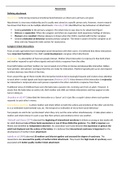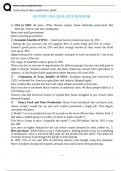Summary Protein Analysis
Lecture 1:
- Small proteins: glucagon, insulin
- Larger proteins: erythropoietin, monoclonal antibody (IgG)
- Protein is made of one or several polypeptide chains which consists of amino acids
- Peptides are polymerized amino acids which are linked together by amide (peptide)
bond formation
- Natural synthesis of proteins occurs in ribosomes, within the cytoplasmic
compartment of cell
Protein function:
- Enzymes (e.g. of metabolic pathways: glycolysis, citrate cycle)
- Structural proteins (fibrinogen, collagen, silk)
- Transporters (transferrin, hemoglobin)
- Membrane transporters (glucose transporter)
- Extracellular signals (hormones, cytokines, insulin)
- Intracellular signals (kinas, transcription factors)
- Signaling receptor (insulin receptor)
- Drugs (natural proteins, new proteins)
Properties:
- Proteins are biopolymers: polarization reaction between the primary amine and
acidic group
o Always one non-reacted amino (basic, pKa of approx. 9) and acidic group
(acidic, pKa of approx. 2) in the protein
- Peptide: < 10 AAs
- Polypeptide: 10 – 50 AAs
- Protein: > 50 AAs
- Proteins can be made up out of 20 different amino acids
o Amide: don’t contribute to charge
o Acidic: can have negative charge (COOH)
o Basic: can have positive charge (NH2)
- Only aromatic amino acids give higher IR absorbance than 200 nm
, - Use abbreviations table
- Side groups have different pKa values
Chirality:
- Most amino acids contain at least one chiral
center
- Naturally occurring amino acids incorporated
during protein biosynthesis are generally
L-amino acids (left-turning)
- D-amino acids may be produced by bacteria,
or may be specific disease marker
Peptide bond:
- Shows mesomerism: electron pair can move
and form a double bond resonance
- Gives restricted rotation stable structure
Isoelectric point (pI):
- Proteins are amphoteric: can both be positive and negative charged
- Proteins always carries charge
- Net charge depends on pH
- pI is the pH at which the protein has net charge of zero
- pI estimate: sum of all pKa values divided by n
o Not accurate for folded protein
- Charge:
o Low pH: positively charged
o pH = pI: protein has no net charge
o High pH: negatively charged
End group protection:
- Groups are reactive protect reactive groups to prevent it from reacting
- Amino group is mostly protected by acetylation (NH 2 NH2 – C=O – CH3)
- Acidic group are protected by amidation (OH NH2)
Structures:
- Primary: sequence of amino acid residues
- Secondary: locally recurring structural patterns (e.g.
alpha helix, beta sheet)
- Tertiary: 3D folding of polypeptide
- Quaternary: spatial arrangement of protein subunits
Determination of primary structure:
- Edman cycle: one by one characterize the last amino
acid
- Nowadays MS can also give information
,Secondary structure:
- Periodical repetition of specific structure in amino acid chain
- Defined by H-bonding between N-H and C=O of amide groups of the amino acid chain
- Two basic structures: alpha-helix and beta-pleated sheet
- When no periodical structure: random coil
- Disulfide bridge: cysteines react and form intramolecular disulfide bridges
Alfa-helix:
- Per 360 turn 3.6 amino acids
- Each turn is 0.54 nm
- Hydrogen bond between N-H and C=O are 3 amino acids away from each other
- Proline can ‘disturb’ helix conformation (can be used to stop helix conformation)
Beta-sheet:
- Same interaction: H-bonding between N-H and C=O
- Interaction doesn’t come from same chain, but from the one which is parallel
structure will be flat
- Example: proteins with beta barrel inserted in membranes forming pores and
transporters
Tertiary structure:
- 3D structure in atomic resolution
- Folding to native functional form
- Physical forces responsible for tertiary structure:
o Ionic forces
o Van der Waals forces
o Hydrogen bonding
o Hydrophobic interactions: entropic effect
o Disulfide bridges: covalent cysteine-cysteine bond
- Measuring 3D structure: X-ray crystallography for solid proteins perfect protein
crystals (ca. 50 mg) is needed (very pure proteins required)
Quaternary structure: association of several protein subunits to one functional unit
Post-translational modifications (PTMs):
- Not encoded in DNA
- Phosphorylation: ATP reacts with protein OH is replaced by O – PO32- pI changes
(will be lower)
- Acetylation: deactivation by adding acetyl group
- Glycosylation: one protein has different glycans
o Determines efficacy, half-life, toxicity
o Shows inherent variability due to bioproduction; affects function
o Inherently heterogeneous and structural complex
o N-linked glycan: conjugated to asparagine (N)
o O-linked glycan: conjugated to serine (S)
o Glycan building blocks: glucose, galactose, mannose, fucose, glucosamines,
sialic acid
, Lecture 2 and 3: Protein Chromatography
- Differential migration of sample components provides separation in space / time
- Chromatography: difference in migration due to specific retention ‘stop-and-go’
LC of intact proteins:
- Preparative: for purification/isolation in protein production
o Mostly used in downstream processing (DPS)
set of operations to purify biological
protein product
Isolation of product protein and
removal of: host cell impurities,
unused media components, viruses,
aggregates, extractables and
leachables
o Aims: sufficient quantities, required purity,
highest throughput and low price
o Product quality requirements: purity, potency and consistency
o Potency: separation using mild aqueous buffers (no organic, extreme pH)
o Industrial purification: upstream cell culturing on large scale (biology)
One goal: only gain one protein as pure as possible and in as large
amounts as possible volume overloading, mass overloading, higher
flow rate and non-linear region isotherm (k will be affected, out of
linear range)
Preparative columns have much larger particle size, column diameter
not optimal, but want to be fast and handle large samples (low
pressure LC)
- For analytical separation:
o Separately assign certain compounds in mixture
o Limited injection volume, analyte concentration and region isotherm (k
concentration in stationary phase to mobile phase is linear)
o Efficient analytical protein separation is challenging but growing
importance in biopharmaceutical industry and top down proteomics
o Problem: often low separation efficiencies low and broad peaks
Plate height depends on A, B and C term (Van Deemter) and the linear
flow rate (u)
A: Eddy diffusion column contribution (flow path) no problem
B: Longitudinal diffusion diffusion of molecules in all directions
bigger diffusion, more band broadening favorable for proteins (big
molecules)
C: Mass transfer equilibrium between mobile- and stationary phase
proteins have low diffusion coefficients C term is problem
Lecture 1:
- Small proteins: glucagon, insulin
- Larger proteins: erythropoietin, monoclonal antibody (IgG)
- Protein is made of one or several polypeptide chains which consists of amino acids
- Peptides are polymerized amino acids which are linked together by amide (peptide)
bond formation
- Natural synthesis of proteins occurs in ribosomes, within the cytoplasmic
compartment of cell
Protein function:
- Enzymes (e.g. of metabolic pathways: glycolysis, citrate cycle)
- Structural proteins (fibrinogen, collagen, silk)
- Transporters (transferrin, hemoglobin)
- Membrane transporters (glucose transporter)
- Extracellular signals (hormones, cytokines, insulin)
- Intracellular signals (kinas, transcription factors)
- Signaling receptor (insulin receptor)
- Drugs (natural proteins, new proteins)
Properties:
- Proteins are biopolymers: polarization reaction between the primary amine and
acidic group
o Always one non-reacted amino (basic, pKa of approx. 9) and acidic group
(acidic, pKa of approx. 2) in the protein
- Peptide: < 10 AAs
- Polypeptide: 10 – 50 AAs
- Protein: > 50 AAs
- Proteins can be made up out of 20 different amino acids
o Amide: don’t contribute to charge
o Acidic: can have negative charge (COOH)
o Basic: can have positive charge (NH2)
- Only aromatic amino acids give higher IR absorbance than 200 nm
, - Use abbreviations table
- Side groups have different pKa values
Chirality:
- Most amino acids contain at least one chiral
center
- Naturally occurring amino acids incorporated
during protein biosynthesis are generally
L-amino acids (left-turning)
- D-amino acids may be produced by bacteria,
or may be specific disease marker
Peptide bond:
- Shows mesomerism: electron pair can move
and form a double bond resonance
- Gives restricted rotation stable structure
Isoelectric point (pI):
- Proteins are amphoteric: can both be positive and negative charged
- Proteins always carries charge
- Net charge depends on pH
- pI is the pH at which the protein has net charge of zero
- pI estimate: sum of all pKa values divided by n
o Not accurate for folded protein
- Charge:
o Low pH: positively charged
o pH = pI: protein has no net charge
o High pH: negatively charged
End group protection:
- Groups are reactive protect reactive groups to prevent it from reacting
- Amino group is mostly protected by acetylation (NH 2 NH2 – C=O – CH3)
- Acidic group are protected by amidation (OH NH2)
Structures:
- Primary: sequence of amino acid residues
- Secondary: locally recurring structural patterns (e.g.
alpha helix, beta sheet)
- Tertiary: 3D folding of polypeptide
- Quaternary: spatial arrangement of protein subunits
Determination of primary structure:
- Edman cycle: one by one characterize the last amino
acid
- Nowadays MS can also give information
,Secondary structure:
- Periodical repetition of specific structure in amino acid chain
- Defined by H-bonding between N-H and C=O of amide groups of the amino acid chain
- Two basic structures: alpha-helix and beta-pleated sheet
- When no periodical structure: random coil
- Disulfide bridge: cysteines react and form intramolecular disulfide bridges
Alfa-helix:
- Per 360 turn 3.6 amino acids
- Each turn is 0.54 nm
- Hydrogen bond between N-H and C=O are 3 amino acids away from each other
- Proline can ‘disturb’ helix conformation (can be used to stop helix conformation)
Beta-sheet:
- Same interaction: H-bonding between N-H and C=O
- Interaction doesn’t come from same chain, but from the one which is parallel
structure will be flat
- Example: proteins with beta barrel inserted in membranes forming pores and
transporters
Tertiary structure:
- 3D structure in atomic resolution
- Folding to native functional form
- Physical forces responsible for tertiary structure:
o Ionic forces
o Van der Waals forces
o Hydrogen bonding
o Hydrophobic interactions: entropic effect
o Disulfide bridges: covalent cysteine-cysteine bond
- Measuring 3D structure: X-ray crystallography for solid proteins perfect protein
crystals (ca. 50 mg) is needed (very pure proteins required)
Quaternary structure: association of several protein subunits to one functional unit
Post-translational modifications (PTMs):
- Not encoded in DNA
- Phosphorylation: ATP reacts with protein OH is replaced by O – PO32- pI changes
(will be lower)
- Acetylation: deactivation by adding acetyl group
- Glycosylation: one protein has different glycans
o Determines efficacy, half-life, toxicity
o Shows inherent variability due to bioproduction; affects function
o Inherently heterogeneous and structural complex
o N-linked glycan: conjugated to asparagine (N)
o O-linked glycan: conjugated to serine (S)
o Glycan building blocks: glucose, galactose, mannose, fucose, glucosamines,
sialic acid
, Lecture 2 and 3: Protein Chromatography
- Differential migration of sample components provides separation in space / time
- Chromatography: difference in migration due to specific retention ‘stop-and-go’
LC of intact proteins:
- Preparative: for purification/isolation in protein production
o Mostly used in downstream processing (DPS)
set of operations to purify biological
protein product
Isolation of product protein and
removal of: host cell impurities,
unused media components, viruses,
aggregates, extractables and
leachables
o Aims: sufficient quantities, required purity,
highest throughput and low price
o Product quality requirements: purity, potency and consistency
o Potency: separation using mild aqueous buffers (no organic, extreme pH)
o Industrial purification: upstream cell culturing on large scale (biology)
One goal: only gain one protein as pure as possible and in as large
amounts as possible volume overloading, mass overloading, higher
flow rate and non-linear region isotherm (k will be affected, out of
linear range)
Preparative columns have much larger particle size, column diameter
not optimal, but want to be fast and handle large samples (low
pressure LC)
- For analytical separation:
o Separately assign certain compounds in mixture
o Limited injection volume, analyte concentration and region isotherm (k
concentration in stationary phase to mobile phase is linear)
o Efficient analytical protein separation is challenging but growing
importance in biopharmaceutical industry and top down proteomics
o Problem: often low separation efficiencies low and broad peaks
Plate height depends on A, B and C term (Van Deemter) and the linear
flow rate (u)
A: Eddy diffusion column contribution (flow path) no problem
B: Longitudinal diffusion diffusion of molecules in all directions
bigger diffusion, more band broadening favorable for proteins (big
molecules)
C: Mass transfer equilibrium between mobile- and stationary phase
proteins have low diffusion coefficients C term is problem






